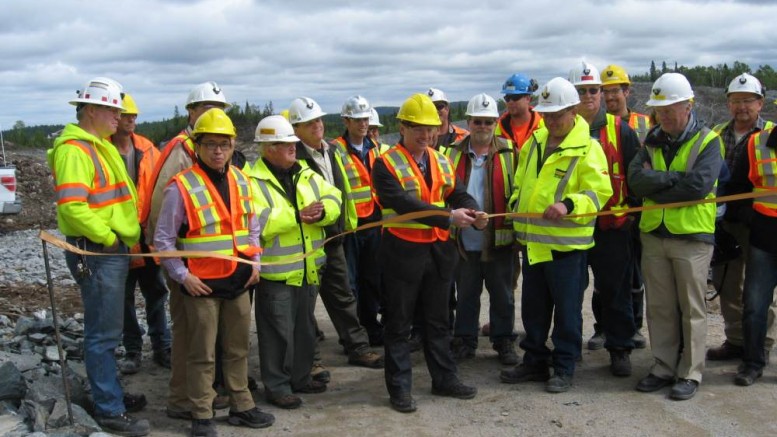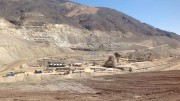While many juniors embrace a mantra of growth at any cost, pursuing pricey takeovers or drilling endlessly to produce impressive-sounding resource estimates, Wesdome Gold Mines (WDO-T) takes a different tack.
With a decidedly conservative approach to growth, the small gold miner is looking to strengthen its foundations by squeezing out all the value it can from its existing Ontario and Quebec properties.
“[Mining] is a high-risk business to start with, so I prefer an approach whereby you grow in small increments, organically through — hopefully — reinvestment of cash flow,” says Wesdome president and CEO Donovan Pollitt.
The company’s newest mine, Mishi, in Wawa, Ont., began commercial production in the first quarter, and is expected to contribute a modest 9,000 oz. gold to Wesdome’s overall production of 60,000 oz. this year, and nearly 53,000 oz. over five years.
Those may not be an eye-catching numbers, but Mishi will help bring Wesdome’s 900-tonne-per-day Eagle River mill, just 2 km east, up to full capacity. The high-grade, low-tonnage Eagle River mine nearby only provides half the 310,000 tonnes per year of mill feed the plant can handle, and by bringing it up to full speed, Wesdome can lower costs and optimize production.
Mishi has been in Wesdome’s portfolio since 2000, when Wesdome predecessor River Gold Mines acquired a 75% stake in the property. Between 1999 and 2007, it was mined on a small scale intermittently, to supplement ore from the Eagle River operation.
Wesdome bought the remaining 25% of Mishi in 2009, when the combination of rising gold prices and the need for mill feed at Eagle River added potential to the project’s larger-scale development. (A royalty of $1 per tonne mined and milled, or $2 per tonne for underground mining, will kick in after 700,000 tonnes from Mishi is milled, including a previously mined 134,200 tonnes.)
As Wesdome’s lone open-pit operation, Mishi has a proven and probable reserve of 52,950 recoverable contained oz. gold in 709,400 tonnes grading 2.55 grams gold per tonne. The estimate uses a cut-off grade of 1.33 grams gold and a gold price of $1,033 per oz., with a pit depth modelled to 80 metres.
Measured and indicated resources hint at greater potential, however, with 5.2 million tonnes grading 2.14 grams gold for 356,132 oz., at a cut-off grade of 1 gram gold. Inferred resources add another 764,100 tonnes grading 2.42 grams gold for 59,000 oz.
While the next few years are focused on feeding Eagle River, longer term, Mishi could inspire a mill expansion — or perhaps even a new mill.
“We’re constrained right now by our mill,” Pollitt said during a presentation at the European Gold Forum in April, noting that production at Mishi could easily be doubled to 1,000 tonnes per day with the existing pit equipment.
“The first step is ensuring that we’re making money — this is generating free cash. Once we’ve ensured that at 500 tonnes a day, what we need to do is look into the cost of upgrading the mill to 1,500 tonnes a day, maybe 2,000 tonnes a day, and seeing if we can make this an 18,000 oz. producer or a 27,000 oz. producer.”
The company has also tallied an underground resource estimate at the shear-hosted vein deposit: 567,100 tonnes grading 4.52 grams gold for 82,300 oz. gold in the measured and indicated categories, at a cut-off grade of 3 grams gold per tonne, and 437,600 inferred tonnes grading 5.78 grams gold for 81,400. (Future underground development could be aided by an existing 800-metre underground drift from the adjacent, past-producing Magnacon property.)
While the numbers may not impress a market used to big promises, in Pollitt’s view, the conservative approach is the right one — especially given the terrible performance of gold equities lately.
“Right now, what you’re seeing is a reaction to a lot of people using the word ‘growth’ a little bit too much, and not being able to succeed at growth,” says Pollitt, a mining engineer who also holds a chartered financial analyst designation.
“That’s why we’re starting slowly with Mishi. It’s very tempting to want to take a deposit like Mishi that has a large number of ounces on a global inferred basis and come up with a fancy presentation to say this thing is going to be a 100,000 oz. a year mine for five years, pending a $280-million capital infusion for a 15,000-tonne-a-day mill, or some such grandiose plan.”
Wesdome has produced more than 1 million oz. gold from five mines over its 25 years in operation. This year it projects it will produce 60,000 oz. overall (including 28,000 oz. at Eagle River and 23,000 oz. at Kiena), or a 25% increase over last year.
The company is also exploring at its Kiena mine in Val-d’Or, Que., and at Eagle River, but Pollitt says that Mishi is where he sees the most potential going forward.
Mishi is located in the regional Mishibishu deformation zone, which follows a mafic volcanic-sedimentary contact in the Michipicoten-Mishubishu greenstone belt.
The deposit strikes east–west, dips 40 degrees north and is open to the east, west and at depth. Gold is hosted in quartz veins that lie within the deposit’s eight tabular, en echelon alteration zones, one of which comes to surface. The company says that the mineralization is more vein-dominant to the west, while in the east, it’s broader, lower-grade and more disseminated.
To help distinguish waste from ore at the operation, samples are taken from each blast hole, which are drilled 4 feet apart, and analyzed at the company’s lab in Wawa.
“Sampling is important,” Pollitt said before an official mine opening ceremony in May. “It may sound mundane, but it’s the difference between ore going to the waste pile and waste going to the mill.”
A November 2010 prefeasibility study outlined Mishi’s net present value at $4.5 million at a 5% discount rate, and projected an internal rate of return of 38% with a capital cost of just $1.3 million. The life-of-mine strip ratio over five years, including eight months of pre-production, was estimated at 4.7 to 1, while life-of-mine operating cash costs were forecast at US$848 per oz.
That’s considerably lower than the company’s average first-quarter cash cost of US$1,400 per oz.
Costs have escalated at both of Wesdome’s underground mines over the past two years, even as the price of gold has risen. Both Kiena and Eagle River have been yielding less gold as mining proceeds through lower-grade sequences of ore.
Unplanned dilution, especially at Kiena, where two small stopes caved in last year, also hurt the bottom line.
At the same time, high labour turnover and the hot money that had been pouring into junior golds until recently both ramped up costs.
As a result, earnings declined to $3.2 million in 2010 and $200,000 in 2011, from a healthy $9.4 million in 2008 and a record $32.2 million in 2009. (Production in 2009 reached a record high of 96,000 oz. gold.)
Near-mine exploration at Kiena has, however, produced promising high-grade results, including a 13-metre intersection of 16.75 grams gold from a new zone called Dubuisson North.
And like 2008 and 2009, this year and next should see the company mining higher-grade sections at Kiena and Eagle River once again.
“What we’re doing right now is we’re developing higher-grade zones at depth at Eagle River and we’re hoping that with the return to life-of-mine grades of 9 to 10 grams gold, you’ll see a return to profitability,” Pollitt said at the Gold Forum in Zurich. “The same goes for Kiena: we&rsq
uo;re developing a bunch of new zones in new areas — the 3D8 zone, the Martin zone, the S50 at depth — and these zones have higher-grade intersections in them.”
On the cost front, the recent drop in stock prices has provided some relief, resulting in an easing of the labour market and drill costs, as smaller companies haven’t been financing and committing to big drill programs, Pollitt says.
“That’s actually good for producers who are trying to pull money out of the ground and pay cash to shareholders,” he told delegates in April.
Although Wesdome’s $5-million to $6-million drilling budget for 2012 is focused on mine exploration and extending known zones for production over the next three to five years, the company spent $11 million at Eagle River and Kiena last year to shore up reserves and resources.
As of December 2011, proven and probable reserves at Eagle River come to 504,000 tonnes grading 10.9 grams gold for 176,000 oz. Kiena holds 1.2 million proven and probable tonnes grading 2.9 grams gold for 116,000 oz.
Inferred resources at Eagle River add 204,000 tonnes grading 7.1 grams gold for 46,000 oz. Measured and indicated resources at Kiena add 1.5 million tonnes grading 3 grams gold for 145,000 oz.
However, not all of the “phenomenal volume of core” generated last year has been logged due to the company’s labour situation, which means another resource update at some point in the future.
“It’s a case of almost biting off a little more than you can chew,” Pollitt says. “We’re just in the process of making sure it’s all compiled and all of our internal resources are updated before we start spending more on long-term exploration.”
Pollitt says he’s “lukewarm” on using reserves as a proxy for value because “at the end of the day, you’ve got to mine the ounces profitably to actually have a business.” But the effort, which was completed without any share dilution, has increased the company’s cushion of reserves to five years, up from two to three years previously. This made Wesdome shares attractive to large, institutional shareholders.
“When people were comfortable owning junior gold stocks, it did help out a lot,” Pollitt says, noting that Wesdome shares traded as high as $3 last year. “Now, we’re in the same boat as everyone else.”
In May, the company issued $7 million in convertible debt maturing in five years, the proceeds of which it planned to use to redeem existing debentures of $10.9 million that matured on May 31.
After both transactions, Wesdome expected to have $16.5 million in working capital and $11.1 million in gold bullion.
Michael Fowler, a mining analyst at Loewen, Ondaatje, McCutcheon, has a “speculative buy” rating on Wesdome with a target of $3.50.
Wesdome shares recently traded at 80¢ in a 52-week range of 75¢–$3.10. It has 101.9 million shares outstanding.






Be the first to comment on "Wesdome goes back to the well with Mishi"